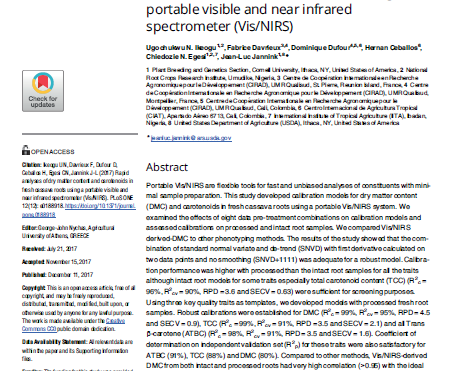Portable Vis/NIRS are flexible tools for fast and unbiased analyses of constituents with minimal sample preparation. This study developed calibration models for dry matter content (DMC) and carotenoids in fresh cassava roots using a portable Vis/NIRS system. We examined the effects of eight data pre-treatment combinations on calibration models and assessed calibrations on processed and intact root samples. We compared Vis/NIRS derived-DMC to other phenotyping methods. The results of the study showed that the combination of standard normal variate and de-trend (SNVD) with first derivative calculated on two data points and no smoothing (SNVD+1111) was adequate for a robust model. Calibration performance was higher with processed rather than the intact root samples for all the traits although intact root models for some traits especially total carotenoid content (TCC) (R2c = 96%, R2cv = 90%, RPD = 3.6 and SECV = 0.63) were sufficient for screening purposes. Using three key quality traits as templates, we developed models with processed fresh root samples. Robust calibrations were established for DMC (R2c = 99%, R2cv = 95%, RPD = 4.5 and SECV = 0.9), TCC (R2c = 99%, R2cv = 91%, RPD = 3.5 and SECV = 2.1) and all Trans β-carotene (ATBC) (R2c = 98%, R2cv = 91%, RPD = 3.5 and SECV = 1.6). Coefficient of determination on independent validation set (R2p) for these traits were also satisfactory for ATBC (91%), TCC (88%) and DMC (80%). Compared to other methods, Vis/NIRS-derived DMC from both intact and processed roots had very high correlation (>0.95) with the ideal oven-drying than from specific gravity method (0.49). There was equally a high correlation (0.94) between the intact and processed Vis/NIRS DMC. Therefore, the portable Vis/NIRS could be employed for the rapid analyses of DMC and quantification of carotenoids in cassava for nutritional and breeding purposes.
Region: Not specific
Date published:
2017
Published by:
PLOS One
Type of resource:
Journal article
Resource topic:
Cassava
Project/Programme: Not specific
Pest/Disease: Not specific
Pages:
17
File type:
External link (1,366 KB )




